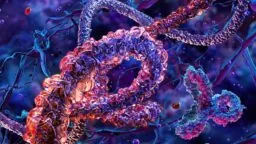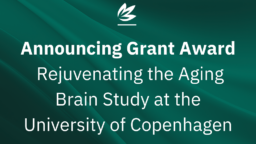May was a substantial month in the rejuvenation biotechnology world, including nanomedical advancements, T cells to fight senescence, a transcription factor with multiple potential uses, and the Hallmarks of Aging lab discussing two more hallmarks.
LEAF News
 Longevity Investor Network 2024 End of Year Update: Developing technologies to defeat age-related diseases by keeping people biologically younger is the goal of the rejuvenation biotechnology field. LRI created the Longevity Investor Network (LIN) to connect promising longevity tech companies with investors to get this technology to the clinic.
Longevity Investor Network 2024 End of Year Update: Developing technologies to defeat age-related diseases by keeping people biologically younger is the goal of the rejuvenation biotechnology field. LRI created the Longevity Investor Network (LIN) to connect promising longevity tech companies with investors to get this technology to the clinic.
Interviews
Michael Levin on Bioelectricity in Development and Aging: Michael Levin, professor at Tufts University and director of Allen Discovery Center, has been working for years on how bioelectrical patterns affect development and aging. His research proves that this often-overlooked part of biology is immensely important and that mastering its mechanisms might one day do wonders for human health and longevity.
Advocacy and Analysis
 Playing the Long Game Towards Radical Life Extension: As Peter Fedichev explains in this op-ed, current techniques can only extend life and health to a limited extent. Slightly more advanced therapies may lead to somewhat more healthspan. For radical life extension, entirely new approaches are needed.
Playing the Long Game Towards Radical Life Extension: As Peter Fedichev explains in this op-ed, current techniques can only extend life and health to a limited extent. Slightly more advanced therapies may lead to somewhat more healthspan. For radical life extension, entirely new approaches are needed.
Well-Known Researchers Discuss Personalized Aging Treatments: The Hallmarks of Aging team has returned to Cell, publishing a detailed review discussing how future methods of dealing with aging might be highly personalized and adding two more hallmarks in the process.
 Is Aging Part of the Immune System?: In this op-ed, Peter Lidsky suggests that aging evolved to stop the spread of chronic pathogens and that without aging, such pathogens would infect the whole population.
Is Aging Part of the Immune System?: In this op-ed, Peter Lidsky suggests that aging evolved to stop the spread of chronic pathogens and that without aging, such pathogens would infect the whole population.
SENS vs. the hallmarks of aging: competing visions, shared challenges: The authors examine their definitions of aging, perspectives on health and disease, approaches to scientific evidence and causal interventions, and communications strategies.
Research Roundup
 Limiting One Protein Maintenance Pathway Enhances Another: In one Aging Cell paper, researchers have explored how transcription factor EB (TFEB) promotes proteostasis in a common aging model.
Limiting One Protein Maintenance Pathway Enhances Another: In one Aging Cell paper, researchers have explored how transcription factor EB (TFEB) promotes proteostasis in a common aging model.
TFEB Lets Cells Live Long Enough to Become Senescent: In a different Aging Cell paper, researchers have explained how TFEB is related to cellular senescence and keeps stressed cells alive.
 Young Microbiota Transfer Reduces Aging Aspects in Mice: In a recent study, lifelong, repeated microbiota transfer from young mice to old mice improves intestinal permeability, coordinative ability, and metabolic profiles while reducing pro-inflammatory responses.
Young Microbiota Transfer Reduces Aging Aspects in Mice: In a recent study, lifelong, repeated microbiota transfer from young mice to old mice improves intestinal permeability, coordinative ability, and metabolic profiles while reducing pro-inflammatory responses.
A New Approach to Treating Aging Skin: Researchers publishing in Aging Cell have found a biochemical pathway that leads skin cells to become senescent along with a potential target for future therapies.
 Gamma Delta T Cells Show Promise Against Cellular Senescence: Scientists from the Lifespan Research Institute have discovered that a subset of T cells effectively targets senescent cells and improves outcomes in a mouse model of idiopathic pulmonary fibrosis.
Gamma Delta T Cells Show Promise Against Cellular Senescence: Scientists from the Lifespan Research Institute have discovered that a subset of T cells effectively targets senescent cells and improves outcomes in a mouse model of idiopathic pulmonary fibrosis.
How Apigenin May Reduce Senescence and Cancer: Screening of a natural compounds library has revealed the senomorphic properties of apigenin. This natural flavonoid also demonstrated rejuvenating effects on many aging-associated molecular features as well as physical and cognitive performance, and it has a beneficial impact on cancer treatment in mice and cells.
 Results of a Phase 1 Trial of Senolytics for Alzheimer’s: The results of a Phase 1 trial of the well-known senolytic combination of dasatinib and quercetin (D+Q) in patients with Alzheimer’s disease have been published in Neurotherapeutics.
Results of a Phase 1 Trial of Senolytics for Alzheimer’s: The results of a Phase 1 trial of the well-known senolytic combination of dasatinib and quercetin (D+Q) in patients with Alzheimer’s disease have been published in Neurotherapeutics.
Nanostructures Trap Amyloid Beta, Rescuing Neurons: Scientists have created engineered nanostructures that bind monomers and oligomers of harmful amyloid beta protein, preventing them from entering neurons and drastically increasing the cells’ survival in vitro.
 Dietary Methionine Restriction Improves Healthspan in Mice: In a recent study, researchers investigated how restricting dietary methionine and inhibiting the tyrosine degradation pathway affects healthspan in aged mice. While affecting tyrosine didn’t show any benefits, methionine restriction improved many, but not all, measures of healthspan, including frailty, pathological disease burden, and neuromuscular function.
Dietary Methionine Restriction Improves Healthspan in Mice: In a recent study, researchers investigated how restricting dietary methionine and inhibiting the tyrosine degradation pathway affects healthspan in aged mice. While affecting tyrosine didn’t show any benefits, methionine restriction improved many, but not all, measures of healthspan, including frailty, pathological disease burden, and neuromuscular function.
Common Laboratory Mice Age Faster in a Natural Environment: In Aging Cell, researchers have found that exposing ordinary Black 6 mice to a more natural environment accelerates rather than slows the aging of their livers.
 Vitamin D Rescues Telomere Attrition in Leukocytes: A sub-study, which was part of the large-scale VITAL trial, determined that vitamin D supplementation slows telomere attrition in leukocytes almost to a halt. This could have real-life clinical implications.
Vitamin D Rescues Telomere Attrition in Leukocytes: A sub-study, which was part of the large-scale VITAL trial, determined that vitamin D supplementation slows telomere attrition in leukocytes almost to a halt. This could have real-life clinical implications.
Caloric Restriction Slows Ovarian Aging in Monkeys: In Aging, researchers have published their discovery that three years of caloric restriction in rhesus macaques that are beginning to enter menopause slows their ovarian aging.
 DNA Methylation Patterns Trace Blood Aging Dynamics: Scientists have created a new, highly effective method of tracing blood cells’ lineage. This can improve our understanding of clonal hematopoiesis and its impact on an aging organism.
DNA Methylation Patterns Trace Blood Aging Dynamics: Scientists have created a new, highly effective method of tracing blood cells’ lineage. This can improve our understanding of clonal hematopoiesis and its impact on an aging organism.
Why Some Mammals Live Much Longer Than Others: A recent study investigated differences in maximum lifespan potential among different mammalian species. The researchers found associations between gene family size expansion, maximum lifespan potential, and relative brain size. They also studied genomic features linked to lifespan evolution.
 How Young Plasma Affects Aging in Older People: A placebo-controlled clinical trial, with results published in Aging Cell, has determined that plasma derived from younger donors has beneficial effects when combined with immunoglobulin, according to multiple epigenetic clocks and -omics biomarkers.
How Young Plasma Affects Aging in Older People: A placebo-controlled clinical trial, with results published in Aging Cell, has determined that plasma derived from younger donors has beneficial effects when combined with immunoglobulin, according to multiple epigenetic clocks and -omics biomarkers.
A Drug Combo Increases Lifespan in Mice by Over 30%: Combining rapamycin with the anti-cancer drug trametinib produced a synergistic effect and robust life extension in a new study. Rapamycin, which was first widely used as an immunosuppressant for transplant patients and is also used in oncology, is considered one of the most powerful geroprotectors.
Association between dietary diversity and healthy aging: a systematic review: Enhancing healthy dietary behaviors for older people is suggested to increase their awareness and, consequently, dietary diversity.
Spicy food consumption and biological aging across multiple organ systems: These findings highlight that spicy foods may slow comprehensive and organ-specific biological aging, especially metabolic and kidney biological aging.
Lifetime walking and Alzheimer’s pathology: A longitudinal study in older adults: Long-duration, high-intensity walking may reduce brain Aβ accumulation, potentially lowering AD risk, particularly when initiated before late life.
Effects of cannabidiol (CBD) treatment on age-related cognitive decline in C57 mice: The findings of this study indicate that CBD reduces inflammatory response in the brain and improves cognitive decline associated with aging.
Intermittent Supplementation With Fisetin Improves Physical Function and Decreases Cellular Senescence in Skeletal Muscle With Aging: Taken together, these findings provide proof-of-concept support for fisetin as a senolytic strategy to improve physical function with aging.
Quercetin Reduces Vascular Senescence and Inflammation in Symptomatic Male but Not Female Coronary Artery Disease Patients: Short-term quercetin treatment effectively targeted vascular senescence in male CAD patients, improving inflammatory and functional outcomes. However, these benefits were not observed in female patients.
Supplementation with Bioactive Compounds Improves Health and Rejuvenates Biological Age in Postmenopausal Women: The results suggest that these bioactive compounds may be a beneficial strategy for promoting healthier aging in postmenopausal women by enhancing immune function, reducing biological age, improving redox balance, and regulating stress hormones.
Co-administration of vitamin D and N-acetylcysteine to modulate immunosenescence in older adults with vitamin D deficiency: A high dose of vitamin D significantly attenuates senescence in some cells of older adults. However, co-administration of N-acetylcysteine with both the standard and high doses of Vitamin D further enhances these beneficial effects.
Systematic transcriptomics analysis of calorie restriction and rapamycin unveils their synergistic interaction in prolonging cellular lifespan: The transcriptional synergistic interaction of CR + RM is validated in extending the lifespan of both yeast and human cells.
Analysis of lifespan across diversity outbred mouse studies identifies multiple longevity-associated loci: Collectively, these loci explained over half of the estimated heritable variation in lifespan across these studies and provided insight into the genetic architecture of lifespan in DO mice.
ElixirSeeker: A Machine Learning Framework Utilizing Fusion Molecular Fingerprints for the Discovery of Lifespan-Extending Compounds: This study demonstrates that ElixirSeeker effectively accelerates the identification of viable anti-aging compounds, potentially reducing costs and increasing the success rate of drug development in this field.
Baricitinib and Lonafarnib Synergistically Target Progerin and Inflammation, Improving Lifespan and Health in Progeria Mice: This preclinical study demonstrates the synergistic potential of this combination therapy in addressing progeria-related systemic and tissue-specific pathologies, offering a promising strategy for enhancing both lifespan and health.
Unveiling the Anti-Aging Potential of 3HB: Lifespan Extension and Cellular Senescence Delay: These findings highlight the promising therapeutic potential of 3HB as an anti-aging intervention and provide novel insights into its underlying mechanisms.
Low-frequency ultrasound reverses insulin resistance and diabetes-induced changes in the muscle transcriptome in aged mice: LFU demonstrates potential as a noninvasive therapy for reducing inflammation and altering immune cell function in skeletal muscle in insulin-resistant and diabetic populations.
News Nuggets
 2060 Longevity Forum: Future Health Meets Smartest Capital: The south of France will host the first edition of the 2060 Longevity Forum, a groundbreaking event designed to position longevity as the greatest investment opportunity of our time.
2060 Longevity Forum: Future Health Meets Smartest Capital: The south of France will host the first edition of the 2060 Longevity Forum, a groundbreaking event designed to position longevity as the greatest investment opportunity of our time.
Longevity Investment More Than Doubled to $8.5bn in 2024: Industry analysts at Longevity.Technology today published the 2024 Annual Longevity Investment Report, a full-year report on the state of investment in the longevity sector, with total financing reaching USD $8.49 billion across 331 deals.
 Grant Award Announcement: Rejuvenating the Aging Brain Study: The Longevity Science Foundation (LSF), a nonprofit organization dedicated to funding research aimed at extending the healthy human lifespan, is proud to announce a grant award to the University of Copenhagen’s Center for Healthy Aging within the Department of Cellular and Molecular Medicine, for the study “Rejuvenating the Aging Brain.”
Grant Award Announcement: Rejuvenating the Aging Brain Study: The Longevity Science Foundation (LSF), a nonprofit organization dedicated to funding research aimed at extending the healthy human lifespan, is proud to announce a grant award to the University of Copenhagen’s Center for Healthy Aging within the Department of Cellular and Molecular Medicine, for the study “Rejuvenating the Aging Brain.”
Circulate Health Publishes Results of Multiomics Study: Circulate Health, the company dedicated to harnessing the potential of therapeutic plasma exchange (TPE) to advance human healthspan and lifespan, today announces the publication of a single-blind, human clinical trial in Aging Cell.
Foundations and Strategic Vision of the Canadian Translational Geroscience Network: With a clear roadmap for future growth, the CTGN aims to position Canada at the forefront of geroscience, fostering evidence-based innovation that improves the health and quality of life for aging populations.
View the article at lifespan.io








































